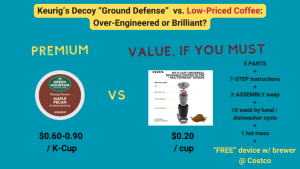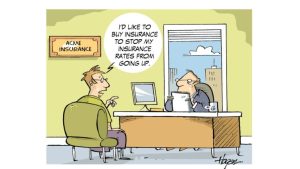Legitimate Pricing Strategy, Poor Execution?
The Department of Justice has sued Uber for charging “wait time” fees to passengers who, because of disability, need more time to enter a car. The lawsuit alleges that Uber “violates the ADA by failing to reasonably modify its wait time fee policy for passengers who, because of disability, need more than two minutes to get in an Uber car.”
Uber answers that its policy never contemplated a penalty for disabled individuals (ahem??). Rather, it aimed to ensure drivers (and, conveniently, Uber) earn something for extra idling time (cost of opportunity). Is this a fair argument?
Pricing Segmentation for consumer brands should consider “cost-to-serve”
Particularly in consumer services (like Uber), there are often behaviors and customer personas associated with higher “usage” or costs. Those higher costs often correlate with higher value received. For example, customers ordering custom-designed wedding invitations (or wedding photo packages) typically use up more resources than non-wedding equivalents. Weddings are in nearly every respect a “higher-value” event driving higher willingness-to-pay (WTP). Businesses wisely segment wedding services as separate offerings and charge more for them. Harvesting higher WTP is not just legal, it’s smart business. Otherwise, everyone else must subsidize a small set of uber-consumers through higher prices overall.
Uber (allegedly) failed to distinguish between a “behavior” driving higher cost-to-serve (extra Wait Time) and a “persona” to segment for higher pricing
It turns out there are at least two “personas” that produce considerably higher Wait Times for Uber drivers:
- The “Unwilling” are those who can get to the car on time, but simply don’t. This includes many business travelers, affluent consumers (high WTP for a timely service), but also the oblivious, poor time managers, the ungracious, and the flat-out rude.
- The “Unable” are those cited by the DOJ, whose legitimate disabilities require extended time to get to the pickup spot and/or into the vehicle. While this includes persons in a wheelchair, cognitive or sensory disabilities would also qualify if they make planning time to the pickup spot difficult to assess, etc. Importantly, not all disabled persons are Unable.
It is surprising that Uber’s uber-sophisticated pricing team (I say this with due respect) didn’t surface this distinction. The “unfairness” (leave alone legal risks) of penalizing both personas in like manner seems obvious in hindsight. Or the fact that they can overlap and cross over. But decisions that appear wrong or simple from the outside (and with hindsight), are often harder in real time. Management teams doing their best under time constraints can make honest mistakes like the rest of us.
Uber is belatedly (and under DOJ pressure) addressing this. It instituted a change last week to automatically waive fees for riders who certify they have a disability. But this new policy may yet backfire, and may be more of a knee-jerk retreat than sound pricing.
Uber drivers should not have to subsidize either the Unwilling or the Unable
Uber drivers suffer economically from uncompensated Wait Time. These hard-working folks already have a hard limitation on their earnings: there is only so much time they can drive. Further, Uber’s algorithms constrain what they make on that time, solving for Uber-centric profits. Uber’s instinct to pass the cost of Wait Time on to customers is correct. But which customers?
What Should Uber Do Now?
For a pricing segmentation strategy to be effective, it must be “enforceable”
If Uber aims to price these customer segments differently, it should be very hard for the Unwilling to pose as Unable (and claim lower pricing, no fees, etc). Here, it is nearly impossible to do this well. For example, I am a person with a disability, but my (invisible) disability comes with no limitations that prevent me from getting to my Uber on time. So I’m not truly Unable. I also occasionally fall in the Unwilling segment … I keep my Uber waiting because I simply fail to plan well. Could everyone like me pose as Unable to shift the cost of my Unwilling behavior on Uber / the Uber driver? Could those with no disability whatsoever claim one? Would this be more attractive for the very Unwilling who incur the highest Wait Time fees?
Many, if not most, disabilities are “invisible”, and virtually all are impossible to adjudicate by non-specialists. Will the passenger’s simple “certification” be all it takes to waive the Wait Time fee? That would make the “segmentation” very porous and open to abuse. Will Uber put its drivers in the business of deciding who’s disabled and who’s not? That would make the current lawsuit feel like a warm-up, and, again, putting undue cost and/or pressure on the drivers.
The newly “fixed” Uber policy becomes a “porous segmentation”
What Uber proposes to do now may prove onerous in new ways. A porous segmentation (e.g. everyone who claims to be disabled can get out of the Wait Time fee), inevitably harvests less from the higher-priced segment. Consumers respond to temptation to “jump the hedge” between the segments, the more so when the difference in pricing is significant. Ultimately, that “leakage” back to the lower-priced segment must be plugged or funds raised to cover the cost elsewhere.
Imperfect Choices All Around
Uber has a choice:
- Continue with its current “leaky” segmentation (as amended last week to give a pass to all self-certified disabled persons), believing it is better/fairer than no segmentation at all, or
- Bow to pressure and eliminate Wait Time fees period, letting the Unable/Unwilling be a “shared cost” that falls mostly to drivers (where it already has a poor recent record of “empathy”), or
- Get rid of Wait Time fees but add a small “wait time tax/surcharge” to every ride. Uber claims current average of Wait Time fees is $0.60 (leaving unclear whether those riders with no Wait Time fees are included in this average), so we’d likely be seeing <1% tacked on each fare (whether itemized or not).
Uber may be best off with the third option. This would spread the cost of supporting both the Unable and the Unwilling across the general rider population. Yes, it is sub-optimal when everyone pays for services that are disproportionately consumed by a relative few. It’s harder when the high cost-to-serve include both sympathetic (Unable) and unsympathetic (Unwilling) consumers. But at least Uber will be treating everyone equally (and making its drivers whole). It will be out of the uber-challenge of price segmentation on disability classifications that it is ill equipped to validate. Uber must know that its reputation in handling the vulnerable is, at best, in need of no further controversies. The limited benefit from this particular segmentation may well not be worth the cost.





